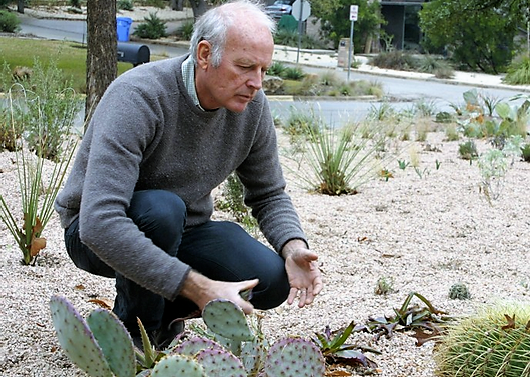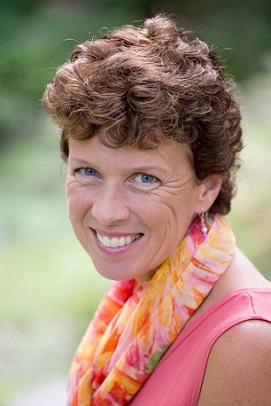I’m excited to announce the first season of Garden Spark talks!

February 2: Scott Ogden presents “The Moonlit Garden”
Description: In Austin’s hot climate, outdoor activity picks up during evening hours as temperatures cool, and this is true for nature as well as people. Many plants and flowers bloom in the evening, and for this reason romantic gardens for nighttime enjoyment have long been part of landscape traditions around the world, as in ancient Persia, with its jasmine-shrouded, enclosed formal plantings centered on rills of water; classical China, with reflecting pools, moon gates, and naturalistic limestone rockwork; and the English white garden composed of plants with silvery foliage and pale, sweet-scented flowers.
Scott Ogden’s visual presentation “The Moonlit Garden” explores how plants with features that shine during evening hours – silvery foliage, pale bark, or white or yellow flowers that can be enjoyed in dim light; glistening, silky textures; dramatic forms; and highly reflective foliage – combine artfully with dark-leaved plants for contrast and with pale native limestone, subtle lighting, and gentle sounds from dripping water to create sensual gardens beautiful day and night.
Bio: Scott is a nationally known speaker and designer of public and private gardens around the country, including the award-winning Tropical Mosaic Garden in Naples, Florida, and the refurbished Sibley Horticulture Center at Calloway Gardens in Georgia. Here in Austin, in addition to many beautiful private gardens, his design work includes the innovative xeriscape garden at Rollingwood City Hall. Scott is the author of The Moonlit Garden, Garden Bulbs for the South, and Gardening Success With Difficult Soils and co-author, with his wife, Lauren Springer Ogden, of Plant-Driven Design and Waterwise Plants for Sustainable Gardens.

March 30: James deGrey David presents “Looking at Gardens: A Personal View”
Description: “I like clarity in a garden. I don’t want my eye to wander and get too far ahead. I want it to be clear what I am looking at. Hardscape (paths, patios, terraces, walls, arbors, and other built features) is a key element in leading the eye through a garden. From the moment you step out of a car and onto a path, you are analyzing the home and garden. First impressions matter not only for your guests but most importantly for yourself. I’ll discuss how to build your garden into an exciting progression of spaces that lead you in and out of your home.
Each garden is unique, influenced by climate, soils, shade and shadow, and exposure to light. Hardscape materials can provide a stage for plants and plantings. Outdoor seating and dining areas, pools and water features, and lighting will be interwoven into ideas of garden design. This will all come together as a series of interrelated possibilities for your home and garden.” – James deGrey David
Bio: Landscape architect James deGrey David, of David/Peese Design, chaired the Garden Conservancy’s Open Days Program for many years and founded Gardens, a boutique nursery and home-goods shop in Austin (closed in 2010). An avid plant collector, James and his partner, Gary Peese, have created a masterwork garden in the Rollingwood neighborhood, which they’ve regularly shared with the public on Open Days tours. After three decades of tending their acclaimed home and garden, the couple are in the process of relocating to Santa Fe.

May 18: Pam Penick presents “Water-Saving Gardens That Wow”
Description: “The recent Texas drought taught us that conserving water in our landscapes is crucially important. But that doesn’t mean our gardening options are limited to cacti and rocks! I’ll talk about design techniques that make the most of natural rainfall and simple ways to conserve water in your garden. I’ll also inspire you to create outdoor spaces that are so beautiful and inviting, it’s hard to believe they are water thrifty.” – Pam Penick
Bio: Pam Penick is author of The Water-Saving Garden: How to Grow a Gorgeous Garden with a Lot Less Water and the bestselling Lawn Gone! Low-Maintenance, Sustainable, Attractive Alternatives for Your Yard. She’s a contributor to such magazines as Garden Design, Country Gardens, and Wildflower, and her photographs have appeared in many books and magazines. On her award-winning blog, Digging, she offers an inspirational mash-up of garden tours, design tips, posts about drought-tolerant plants, and plenty of examples of water-saving gardens. She lives, gardens, and shakes her fist at the plant-noshing deer in Austin.

October 19: Karen Chapman presents “Foliage and Focal Points: Ideas for Gardens and Budgets of All Sizes”
Description: “We all have sections of our gardens we’re dissatisfied with, but understanding what’s wrong can be frustrating. Instinct sends us shopping for more plants — often whatever is blooming that day — in hopes that an injection of color will solve the problem. Yet the sense of dissatisfaction grows, especially when the flowers finish blooming and we’re left with a muddled sea of nondescript leaves.
Focal points can help solve these problem areas. I’ll show why it’s important to establish focal points and talk about three areas where they play an especially important role. We’ll explore the use of containers, structures, water features, and artistic sculptural elements as focal points, and I’ll show how to frame and enhance these with interesting foliage to create memorable vignettes. With ideas for budgets and gardens of all sizes, this presentation will help you to become more confident and knowledgeable about transforming your own garden into a cohesive series of eye-catching scenes.” – Karen Chapman
Bio: Born in England, Karen grew up with a trowel in her hand. After moving to the Pacific Northwest in 1996, she established her award-winning design business Le Jardinet. Her container garden designs and articles have been featured in many publications including Fine Gardening, Country Gardens, and Garden Design.
She is co-author with Christina Salwitz of the newly released Gardening with Foliage First and also the award-winning book Fine Foliage. Karen writes inspirational design articles on two blogs and is a regular contributor to several publications including Fine Gardening. Karen has appeared on local television and radio stations and teaches two online garden design courses for Craftsy including “Gorgeous Garden Design: Foliage & Focal Points” that was mostly filmed in her own 5-acre garden in Duvall, WA.
Karen’s aim is always to inspire, educate, and share the fun of gardening with her audience.

